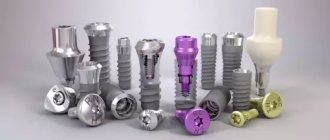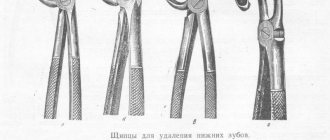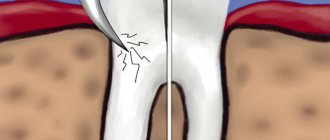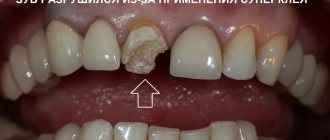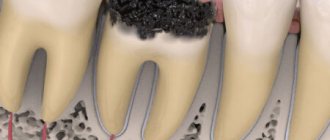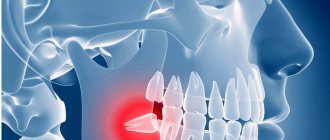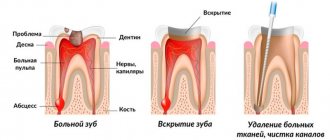Why do teeth rot in adults?
The development of caries and other dental diseases occurs under different circumstances, including:
- Insufficient oral hygiene or its complete absence.
- Poor nutrition, accompanied by the development of excess or deficiency of microelements and vitamins in the body.
- Failure to follow the rules of eating: chewing very cold or very hot food, combining hot and cold, biting into very hard foods.
- Disturbance of metabolic processes in the body.
- Endocrine diseases and temporary hormonal imbalances, due to which the protective properties of saliva are weakened.
- Pathological processes that occur during pregnancy and are associated with the outflow of nutrients from the mother’s body to the developing tissues of the fetus.
- Weak immune activity.
- Hereditary predisposition and improper formation of the dentofacial apparatus.
- The effects of nicotine and alcohol.
- The effect of toxic substances in unfavorable environmental conditions or harmful working conditions.
- Infectious processes due to injuries.
- The presence of untreated infectious processes in any part of the body.
When visiting a dentist, you rarely hear exactly why a particular dental disease has developed. Most often, unfavorable factors act on dental tissues in a complex manner and over a long period of time.
Why do children's teeth rot?
Teeth rot not only in adults, but also in children. In addition to the reasons described, children’s teeth are affected by additional factors that often arise due to the fault of parents:
- Improper nutrition of the mother during pregnancy, due to which the formation of bone and dental tissue of the fetus is abnormal.
- The effect of toxins and medications that enter the mother’s body through smoking, drinking alcohol or self-medicating.
- Long-term use of pacifiers and bottle nipples.
- Night feeding - at night, food particles linger in the mouth for a long time and rot due to the activity of bacteria.
- Late and incorrect teaching of children to maintain hygiene.
- Eating large amounts of sweets, the remains of which create favorable conditions in the mouth for the proliferation of microbes.
Symptoms of dental decay
A person may find out that his tooth has begun to rot too late - when the process of tissue destruction begins to develop in full force and will already cause great harm to the dentin and pulp. The main symptoms of a purulent process are:
- The appearance of stains on the top of the crown or in the cervical area if the root of the tooth rots. If a tooth rots from the inside (from the root canals), then the initial stages of necrosis can only be detected using x-rays: the visible surface of the crown turns black in the later stages of decay.
- Deformation of the tooth surface, the appearance of holes.
- Putrid, rotten odor from decaying tissues, caused by fetid waste products of bacteria that cause the process of decay.
- The appearance of an unusual, unpleasant taste in the mouth due to the entry of pus from the carious cavity or pulp chamber into the oral cavity.
- The appearance and gradual intensification of aching pain.
- Temperature increase.
- Increased accumulation of plaque with pathogenic microflora not only on the dentition, but also on the surface of the tongue or tonsils.
If a tooth has rotted to the root, its crown may completely crumble. Against the background of the destruction of the rotten tooth root, the patient may experience more frequent headaches.
Clinical picture
Symptoms of damaged tooth roots depend on the condition of the pulp and the degree of displacement of fragments. A problem is indicated by:
- pain that intensifies when the upper and lower jaws are closed,
- swelling of soft tissues,
- redness and soreness of the mucous membrane in the damaged area,
- discoloration of the crown part of the tooth in a pinkish color due to internal hemorrhage.
If the root of a tooth with weak walls crumbles after a dental procedure, the doctor will notice this immediately and take measures to solve the problem.
What are the dangers of rotten teeth, consequences for the body
Many people ignore the process of tooth decay unless it is accompanied by severe pain. But the consequences of the carious process can be unpredictable and dangerous. If you have rotten teeth, the following complications may develop:
- Destruction of bone tissue of the musculoskeletal system.
- Endocarditis is inflammation of the lining of the heart.
- Inflammatory pathologies of the kidneys.
- Infections of ENT organs.
- Psychological complexes due to discomfort during communication and dissatisfaction with the appearance of the dentition.
- Purulent-inflammatory diseases in the gums (abscesses, phlegmons) and, as a result, the spread of infection throughout the body, leading to general intoxication.
The health of baby teeth greatly affects the condition of the permanent buds. Therefore, if nothing is done about the decay of milk dental tissues, in the future the child may have big problems with the formation of a permanent dentition.
How to recognize a dead tooth?
When a tooth dies, many adverse reactions occur. With the necessary knowledge, you can easily recognize the problem. Due to irritation of the tissues around the tooth, gum abscess (in the form of a thick discharge consisting mainly of bacteria) and swelling may occur. A dead tooth can also be recognized by its dark, unnatural color, which is the result of cell death, and by its complete lack of response to any stimuli (heat, cold, or electrical stimuli). In the transitional stage preceding the death of the pulp, there may be increased sensitivity to heat and cold, as well as throbbing toothache.
In the last stages of tooth death, fever, chills and jaw pain may appear. Tarnishing of the enamel is also a warning sign. If any of the above symptoms appear, a visit to a specialist may be required to make a final diagnosis.
What to do if your teeth are rotting
Rot inside the tooth is dangerous for the entire body. Therefore, at the first signs of decay of dental tissues, you should go to the dentist.
Before providing first aid, it is recommended:
- Rinse your mouth with a herbal decoction that has anti-inflammatory and antimicrobial effects. It's better to take chamomile and sage.
- Rinse your mouth with a pharmaceutical antiseptic: Chlorhexidine, Miramistin.
- Thoroughly clean the surface of the dentition to prevent the accumulation of soft plaque and its transformation into hard tartar: bacteria multiply under its surface and spoil the enamel even faster.
- You should not try to remove pus yourself by picking at the enamel with a sharp object. This action will provoke even greater destruction of damaged tissue.
- On the side of the jaw where the rotten tooth is located, it is better not to chew anything so that food does not penetrate into the carious holes.
- After eating, you need to rinse the remaining pieces of food with a weak saline solution or boiled water.
Possible complications and consequences
If you do not consult a specialist in time for severe pain in a pulpless tooth, the following serious complications may occur: 1. Purulent inflammation in the tooth (granuloma). 2. Formation of a cyst in the tooth. 3. Loss of the affected tooth. It should be remembered that pain in a pulpless tooth can be normal only in the first few days after treatment. Under other circumstances, the presence of pain in the tooth most likely indicates the development of a pathological process that must be eliminated as soon as possible. In most cases, the appearance of pain when pressing on a tooth or chewing food indicates poor quality treatment. If toothache does not go away a few days after dental procedures, then there is no need to hesitate to visit the dentist. Only a doctor can determine the condition of the tooth, identify the cause of concern and prescribe the necessary treatment. Complications that may develop due to the lack of necessary treatment are much more difficult, longer and more expensive to treat. In addition, lack of treatment can lead to diseases of neighboring healthy teeth. In order not to detect diseases at the complication stage, you need to regularly, every six months, visit the dental clinic for a preventive examination by a specialist. At the Innovative Dental Clinic on Marata-31, dentists conduct free medical examinations for their patients. The clinic employs competent specialists with extensive experience. Treatment in the clinic is carried out using modern equipment, in compliance with all regulatory standards of dental treatment. You can make an appointment with specialists on our website using the online appointment form or by phone. We work seven days a week and will always be happy to find a convenient appointment time for you. Sign up, with us your teeth will be healthy!
Treatment in dentistry
Whether a tooth can be treated depends on the severity of the carious process, so doctors first prescribe x-rays to patients. If the situation is not critical and the dentist can save the tooth from rotting, he carefully cleans it of accumulated deposits (plaque and stone) and begins treatment:
- Anesthesia is performed.
- All areas of enamel affected by the carious process are removed, and the rotting pulp must also be removed.
- The dental cavity is washed with an antiseptic.
- The integrity of the surface is restored with filling material. After the filling is installed and hardened, the patient must check the bite: if discomfort is felt, the excess layer of filling material must be removed.
Teeth that are rotting from the gums are treated in the same way, but photopolymer materials are usually used to fill them. They harden quickly, are characterized by increased strength and high aesthetics.
The dentist may prescribe an antibiotic to prevent the infection from spreading throughout the body. For severe pain, an analgesic is prescribed.
There are methods that can be used to prevent damage to dental tissues by cariogenic bacteria. Almost all dental clinics carry out remineralization - strengthening the enamel structure with special preparations. In a hospital or at home, you can perform fluoridation - saturating the enamel with fluoride.
Causes of pain
Painful sensations in a dead tooth can occur as a result of many different reasons:
- Poorly performed filling of the treated unit. If unfilled areas remain in the dental canals, pain can occur both in the gums and in the tooth itself. If there was a lot of filling material, and it went beyond the limits of the tooth root, then there is a high risk of developing periodontitis, and in some cases even the formation of a cyst in the dental canal.
- Unprofessional actions of a specialist can lead to a fragment of the instrument, which as a result of such actions remains in the tooth canal. It often happens that over time, toothache occurs in such teeth.
- The presence of an inflammatory process.
- Penetration of pathogenic bacteria into the tooth cavity during treatment.
- Incomplete removal of a nerve in a tooth.
- Allergic reaction to filling material.
- The pain radiates from the damaged neighboring tooth.
- The body’s normal reaction to the treatment is the so-called post-filling pain.
- Other reasons.
An x-ray will help diagnose the cause of pain in a pulpless tooth. Painful sensations in a dead tooth can be of different types. Particular attention should be paid to the severity of pain and its duration. If pain bothers you for several days after removal of the nerve, then such aching pain when pressed is considered a normal reaction. In such a situation, experts recommend taking painkillers until the painful sensation goes away on its own. If the nerve was removed poorly during the prosthetic process, then even a healthy tooth can cause pain. The nature of the pain in such a situation is pulsating, and appears not only during exercise, but also at rest.
Do I need to remove rotten teeth?
If a tooth root or crown is completely rotted, it cannot be restored. Such a tooth cannot be left in the jaw so that its purulent contents do not spread to the surrounding tissues. If there is rot in the root canals, it is not possible to make artificial crowns, since they will not be able to fix on the destroyed tissues. Therefore, in advanced situations, dentists prescribe the removal of a rotten tooth, and this operation cannot be refused. After removal, a course of antibiotics may be prescribed.
To prevent your teeth from rotting, you need to regularly monitor their condition. To maintain dental health, you need to adhere to a nutritious diet and maintain oral hygiene, as well as promptly treat any dental and internal diseases. Purulent processes are extremely dangerous, therefore, if the carious process has reached an advanced stage, you should not refuse to remove the diseased tooth.
Is it possible to whiten a dead tooth?
If pulp necrosis is detected, the dentist decides to begin root canal treatment. Once it is completed and the necessary dental materials are applied, the tooth can be considered healed. However, over time, due to the death of all tissues, the tooth changes color and begins to darken. In such a situation, a decision may be made to bleach.
There are several methods used to whiten dead teeth. The first one, the so-called walking whitening, is also called the gradual whitening technique. It involves applying a whitening agent several times inside the tooth and on its surface. Then you can control the shade of the whitened tooth yourself.
Another commonly used method is so-called power bleaching. It involves applying a whitening agent to the tooth and leaving it on for several minutes. Hydrogen peroxide is most often used for this. The procedure can be repeated and thus achieve the ideal shade.
If the previously mentioned methods do not bring the desired effect, you can decide to use veneers or a prosthetic crown. Veneers are special plates glued to the surface of the tooth that perfectly imitate natural teeth. Prosthetic crowns are inlays that allow you to completely restore a tooth. However, both procedures are more invasive as delicate treatment of other teeth may be required.
A large number of people at some stage in their lives are faced with the problem of dying pulp. That is why it is worth knowing how to recognize a dead tooth and what procedures can be performed on it.
Tooth root fracture
The doctor’s tactics for a root fracture are determined by the nature and location of the damage, the age of the patient, and the level of displacement of the fragments. If a transverse fracture of the apical third is detected with a violation of the vitality of the pulp, extirpation of the coronal and root pulp, medicinal and mechanical treatment of the canals are carried out, followed by their filling with temporary calcium-containing paste. After obturation of the root canals using the method of lateral or vertical condensation of gutta-percha, a surgical intervention is performed, the purpose of which, in case of a tooth root fracture, is to remove the broken apical fragment. While maintaining the vitality of the pulp, immobilization of the tooth with a special mouth guard or wire splint fixed to 2 intact teeth on either side of the damaged one using liquid photopolymer material is indicated.
If, with a transverse-median root fracture, irreversible changes in the pulp are not observed, in order to provide the necessary conditions for fusion of the fragments, a mouthguard, fiberglass or wire-composite splint is used. If signs of pulp non-viability are detected, treatment for a tooth root fracture includes the stage of endodontic treatment, installation of a pin with reposition, fixation, and immobilization of fragments. In case of a vertical or oblique fracture, single-rooted teeth must be removed. In case of a fracture of one of the roots of molars or premolars, tooth-preserving operations are performed. When hemisection of a tooth through the chewing surface along the bifurcation in the bucco-oral direction, the crown is cut with a bur. The damaged root is removed. The preserved healthy root is used as a support for prosthetics. Identification of a fracture in the root of a temporary tooth is a direct indication for its removal.
With timely treatment of the patient and skillfully planned treatment of a horizontal fracture of the tooth root of the middle or apical third, the prognosis is favorable. Maintaining pulp viability increases the likelihood of fracture healing, since it is the vital pulp that contributes to the formation of hard tissue in the endodontist. With a horizontal cervical fracture of the tooth root, the prognosis is unfavorable. All temporary, as well as permanent single-rooted teeth with oblique, longitudinal, and comminuted root fractures must be removed, since the dynamics of fusion of the fragments does not occur; patients experience root resorption with signs of a chronic inflammatory process.

